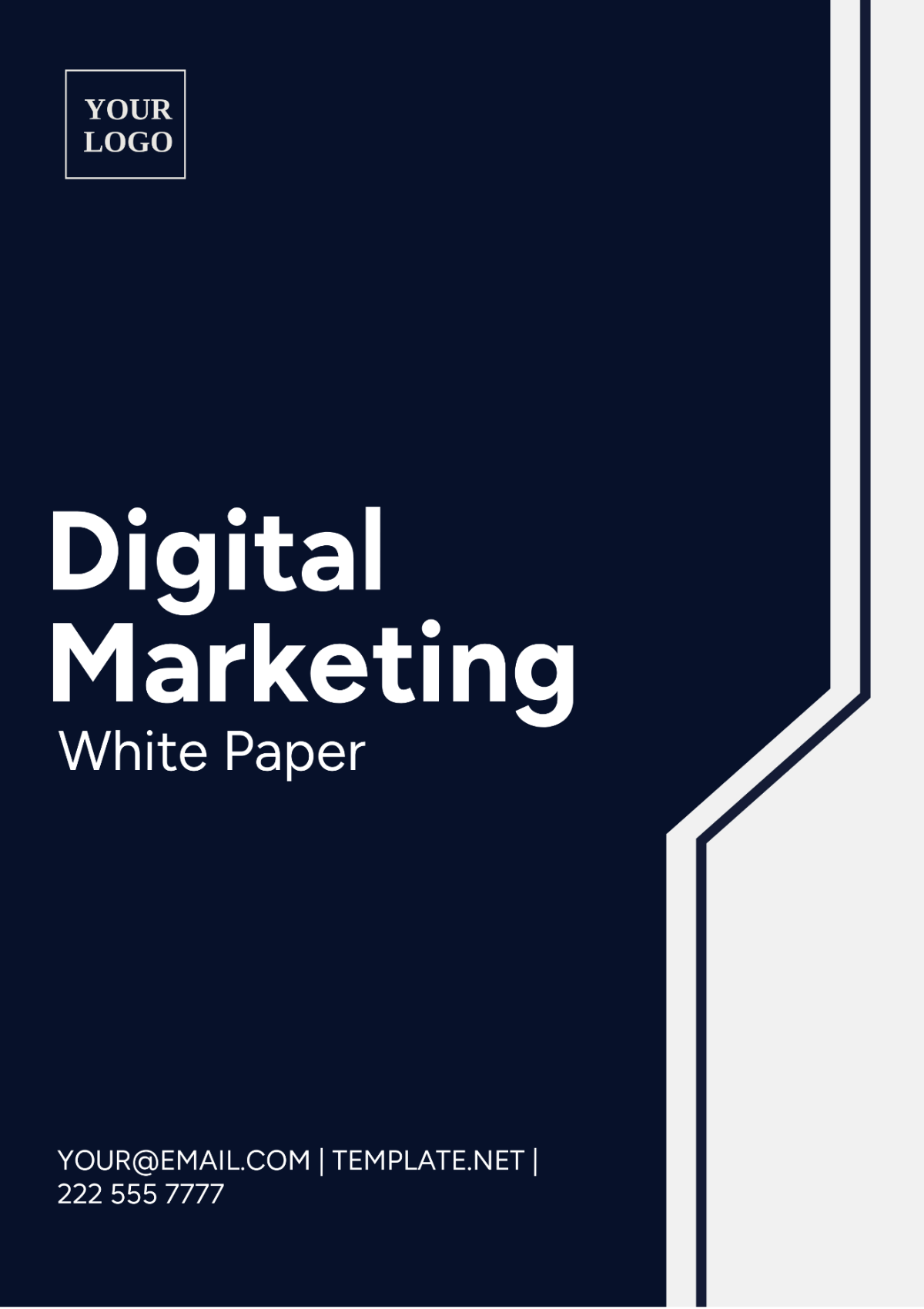Website Design White Paper
White Paper by: [YOUR NAME]
Subject: Website Design Strategies for Enhancing User Experience and Conversion Rates

This white paper provides an in-depth look into the latest trends, strategies, and technologies in website design that businesses, specifically [YOUR COMPANY NAME], can utilize to enhance user experience and improve conversion rates. This document is prepared by [YOUR DEPARTMENT] to guide and inform our team and stakeholders about the effective strategies in web design and development.
I. Introduction
The digital landscape is continually evolving, and keeping up with the latest design trends is essential for any business looking to stay competitive. This section introduces the purpose of the white paper and the significance of innovative website design.
II. Objective
The main objective of this white paper is to explore and outline key website design strategies that integrate user experience (UX) enhancements with conversion rate optimization (CRO) techniques to drive success in online business platforms.
III. Understanding User Experience (UX)
Definition and Importance of UX
User Experience (UX) refers to the emotions and attitudes a person has while using a particular product, system, or service. It encompasses the practical, experiential, affective, meaningful, and valuable aspects of human-computer interaction and product ownership. Good UX enhances customer satisfaction and loyalty by improving the usability, ease of use, and pleasure provided in the interaction with the product.
Components of an Effective UX Design
Usability: The product should be easy to use and navigate.
Functionality: Ensures all features work as intended.
Accessibility: Provides an inclusive experience that can be accessed by users of all abilities and disabilities.
Design: Visually pleasing design that supports overall functionality.
Content Strategy: Involves the creation and management of readable, usable content that is well-structured and fits the user’s needs.
Interaction Design: Focuses on creating engaging interfaces with well-thought-out behaviors.
User Research: Involves understanding user behaviors, needs, and motivations through observation techniques, task analysis, and other feedback methodologies.
Case Study: Success Stories of Excellent UX Implementation
Airbnb: Initially struggled with trust between users and the platform. Improved UX by introducing verified photos, user profiles, and a robust review system which significantly increased bookings and user trust.
Duolingo: Created a highly engaging and interactive app that makes learning a new language fun and easy. Features like daily goals, immediate feedback, and a playful interface keep users motivated and engaged, leading to high retention rates
Nike: Revamped its online store to focus on a more personalized experience. The introduction of Nike ID, allowing users to customize their own shoes, combined with a highly visual and responsive design, significantly enhanced customer satisfaction and increased sales.
IV. Conversion Rate Optimization (CRO) Techniques
Understanding the Basics of CRO
Conversion Rate Optimization (CRO) is a key digital marketing strategy aimed at boosting the proportion of website visitors who take a desired action, such as completing a purchase or signing up for a service. It involves analyzing user behavior to identify barriers and optimize the user journey to increase conversions.
How CRO Complements UX
CRO and UX are interrelated, both striving to enhance user satisfaction. UX prioritizes the product's feel and usability, creating a user-friendly, intuitive, and enjoyable environment necessary for high conversion rates. Conversely, CRO uses these aspects to encourage specific user actions. Effective UX elements such as efficient navigation, quick loading, and appealing design can boost conversions by minimizing friction and increasing user satisfaction.
Implementing A/B Testing for Better Conversions
A/B Testing, also known as split testing, is a key component of CRO strategies. It involves comparing two versions of a webpage or app against each other to determine which one performs better in terms of driving conversions. Here’s how to implement A/B testing effectively:
Identify Conversion Goals: Clearly define what conversion means for your specific context, whether it's email signups, purchases, or another action.
Choose a Variable to Test: Select one variable to change in the variant version, such as the color of a call-to-action button, the headline of a landing page, or the layout of a product page. Changing one variable at a time helps pinpoint what influences the outcome.
Create a Hypothesis: Based on user feedback and analytics, hypothesize why changing this variable might improve conversions.
Run the Test: Use A/B testing software to serve both the control and the variant to an equal number of users simultaneously. Ensure your sample size is large enough to provide statistically significant results.
Analyze Results: Evaluate which version performed better using your established metrics. Look for statistical significance in the results to ensure that the observed differences are not due to random chance.
Implement and Iterate: If the test is successful, implement the winning version and use the insights gained to drive further tests and improvements.
V. Integrating UX and CRO in Website Design

Integrating User Experience (UX) and Conversion Rate Optimization (CRO) into website design involves a balanced approach that focuses on pleasing the user while subtly guiding them toward conversion goals. Here are practical strategies for achieving a cohesive integration of UX and CRO:
1. Understand Your Users
Begin with detailed user research using surveys, interviews, user testing, and analytics to understand user preferences, behaviors, and challenges. Use this data to guide all design and optimization efforts, making decisions rooted in actual user needs rather than assumptions.
2. Define User Personas
Develop detailed user personas for website audience segments to guide design, enhancing tailored experiences that boost emotional resonance and conversions.
3. Map the User Journey
Create a concise user journey map detailing steps from site entry to conversion completion, highlighting critical UX and CRO interaction points to facilitate smoother conversions.
4. Focus on Usability
Ensure your website is user-friendly and accessible, with simplified processes and fast load times to enhance usability and boost conversion rates.
5. Optimize Information Architecture
Structure your website with user-focused content and navigation identified in the research phase to enable quick information access, boosting satisfaction and conversion rates.
6. Employ Engaging and Persuasive Design Elements
Strategically employ design elements like contrasting colors for CTA buttons, whitespace to minimize clutter, and impactful visuals to direct users’ focus towards key conversion points.
7. Conduct Continuous A/B Testing
Regularly conduct A/B testing on your website to optimize elements like CTA button placement, headline wording, image selection, and page layouts for better conversion rates.
8. Incorporate Feedback Mechanisms
Enable easy feedback on your website to enhance user experience and gather valuable insights for optimizing the user journey.
9. Use Analytics to Monitor and Adapt
Use analytics tools to track changes in user behavior and conversion rates by examining metrics such as bounce rate, session duration, and conversion rates at different funnel stages to identify drop-off points and reasons.
10. Balance Aesthetic with Functional Design
Ensure your design's aesthetic enhances functionality, attracting attention while supporting usability to boost conversions.
VI. Technology and Tools
Overview and examples of cutting-edge technologies and tools that can be utilized to create responsive, intuitive, and visually appealing designs:
Technology | Description | Impact on UX/CRO |
|---|---|---|
HTML5 | Latest HTML standard that supports modern web experiences | Enhances functionality and user interaction |
CSS Grid | Powerful layout system in CSS | Allows designers to create complex, responsive web layouts easily |
JavaScript Frameworks (e.g., React, Vue) | Help in building interactive UIs | Improves site speed and user engagement |
VII. Best Practices in Website Design
Mobile First Design: Importance and Implementation
Accessibility Features: Ensuring Inclusivity
Visual Hierarchy and Readability
VIII. Case Studies
Analysis of successful website redesigns that resulted in improved UX and elevated conversion rates.
IX. Conclusion and Recommendations
Summarize key findings and offer actionable recommendations for [YOUR COMPANY NAME] moving forward.
X. About the Author
[YOUR NAME] is a member of [YOUR DEPARTMENT] at [YOUR COMPANY NAME], specializing in innovative digital solutions and engaging website creation.

















































